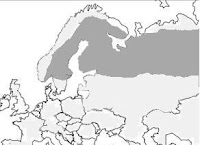The name 'Sarmatic Mixed Forests' is used in the
World Wide Fund for Nature classification (ecoregion PA0436) for a European ecoregion extending over a
sizable portion of northern Europe and the Ural area of Russia: "between boreal forests/taiga in the north and the broadleaf belt in the south [...] in southernmost Norway, southern Sweden, southwesternmost Finland, Estonia, Latvia, northern Lithuania, northern Belarus and the central part of European Russia". It extends to the Urals in the east and borders on the forest steppe on the south, and is treated as separate from the Central European mixed forests.
The ecoregion is abundant in surface water resources, with more than ten thousand lakes and 20,000 rivers and streams, this leads to the creation of boggy forests, that
are particularly rich in wetland plants on the forest floor.
Typically, Sarmatic mixed forests comprise a transition into boreal taiga at their northern limit and mixed broadleaf forests at their southern limit. They are comprised of a mixed conifer broadleaf plant association dominated by Norway Spruce (Picea abies - which disappears further south due to insufficient moisture) and Scots Pine (pinus sylvestris - in drier locations) with some broadleaf admixture, especially oak species such as Quercus robur in the north. Toward the southern limits of the ecoregion is a conspicuous increase in broadleaf tree species including birch, beech, aspen, ash, aspen and oak. There are also a number of shrubs, wildflowers, grasses and mosses that inhabit the mid-tier and forest floor. Common low-growing shrubs include Bilberry (Vaccinium myrtillus) and Heather (Calluna vulgaris).
It is interesting to note that the name refers to a passage in the Germania of Tacitus.
Source:
C Michael Hogan (Lead Author);Sidney Draggan Ph.D. (Topic Editor) "
Sarmatic mixed forests". In: Encyclopedia of Earth. Eds. Cutler J. Cleveland (Washington, D.C.: Environmental Information Coalition, National Council for Science and the Environment). December 3, 2010.
Globalspecies.org Google map

























